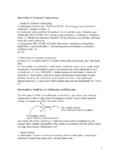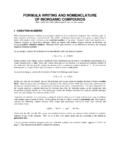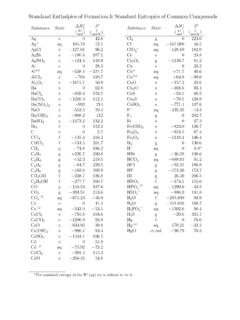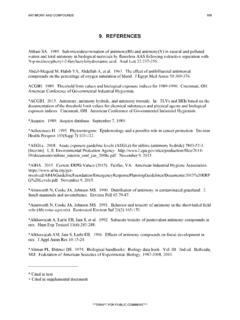Transcription of Substitution Reactions of Aromatic Compounds …
1 1 Substitution Reactions of Aromatic Compounds Simple alkenes tend to undergo addition Reactions : The elements of the reagent (HBr or Br2) are simply added to the starting material. This is called, unsurprisingly, an addition reaction. Aromatic Compounds do not react in this manner; and it usually takes a catalyst to initiate reaction with halogens: What we have done in this case is substitute a bromine atom for a hydrogen atom. Hence the reaction is termed an Aromatic Substitution . Because the benzene ring is quite electron-rich, it almost always behaves as the nucleophile in a reaction - which means that the Substitution on benzene occurs by the addition of an electrophile to benzene; thus, the Reactions are termed electrophilic Aromatic Substitution : There is basically one simple mechanism for all electrophilic Aromatic substitutions: The benzene acts as a nucleophile, attacking the electrophile with a pair of its -electrons.
2 This initial step destroys the aromaticity of the molecule! The resulting positive charge is delocalized over the ortho and para positions. The conjugate base of the initial electrophile then assists in removing the now extraneous proton, and restores aromaticity. Note that addition of the conjugate base to the cyclohexadienyl cation (an addition reaction) does not occur because the addition reaction is much less exothermic than the rearomatization reaction and cannot compete with it. Because all electrophilic Aromatic substitutions proceed in this way, the only thing that matters is the preparation of a reactive electrophile. Why a reactive electrophile? As you can see, the first step of the reaction involves destroying aromaticity.
3 In order to do this, there must be a 2 significant energetic driving force. This driving force comes in the form of a very reactive (unhappy) electrophile. How are such electrophiles generated? Halogenation As you can imagine, halogens bearing a positive charge are particularly reactive. We will focus on preparing halogen electrophiles from Br, Cl and I. Bromine: Allowing bromine to react with iron metal first generates FeBr3, which then interacts with the remaining Br2 to form a highly Lewis acidic system that is capable of reacting with weakly nucleophilic Aromatic Compounds : The reaction proceeds by the mechanism shown below to give brominated benzene: Chlorine: The same chemistry shown for bromine also works with chlorine togenerate Cl+.
4 A mixture of benzene, chlorine and iron(III)chloride yields the chlorobenzene: Iodine: It is a little more difficult to make iodine sufficiently electrophilic. For relatively activated Compounds , where a mild source of I+ is required, copper salts are often used as a catalyst: Reaction then proceeds by the standard mechanism, with I+ as the electrophile, to give iodinated benzenes. What good are Aromatic halides? The halogens are excellent synthetic handles they can be easily converted into other functional groups. For 3 example, bromobenzenes can be turned into Grignard reagents, and then reacted with aldehydes, ketones, Nitration We can also make a highly electrophilic form of NO2 (from HNO3/H2SO4), the nitronium ion: Which can then react with Aromatic Compounds via the standard mechanism to give nitrated Why nitrate aromatics?
5 There are a couple of good reasons to nitrate things. The first is in the manufacture of explosives highly nitrated organic molecules are frequently used as explosives (trinitrotoluene (TNT), nitroglycerine, etc.). The second reason is that nitro-groups are generally easy to reduce to amines. And since it is nearly impossible to make an amine electrophilic (in order to add it to an Aromatic ring under electrophilic Aromatic Substitution conditions), Aromatic nitro Compounds are about the only precursors to Aromatic amines: 4 Sulfonation Just as with nitration, it is easy to make a solution of highly electrophilic SO3 (SO3/H2SO4). This solution can be used to sulfonate Aromatic Compounds : Why is this a useful reaction?
6 First of all, the reaction is REVERSIBLE, especially at high temperature! Cook it up in hot AQUEOUS acid, and the SO3 group falls right off again. Second, Aromatic sulfonic acids were used as the first antibiotics - the so-called sulfa drugs, such as sulfanilamide. Friedel-Crafts Reactions : This reaction comes in two flavors - alkylation and acylation. Alkylation first: The basic premise of this reaction is the electrophilic addition of alkyl groups to an Aromatic ring. The general scheme: whether a true carbocation is formed depends on the nature of the R group A simple example: There are a number of drawbacks to this reaction: 1) Does not work at all on Aromatic rings with de-activating groups (nitro, any carbonyl, cyano) attached.
7 2) Because alkyl groups are activating, over-alkylation is a significant problem. 3) Because a carbocationic intermediate is involved, rearrangements tend to take place. For example, 5 However, Friedel & Crafts came up with another reaction without so many drawbacks. The Friedel-Crafts acylation generally proceeds without complication (through an acylium ion): For example: Note: the only significant restriction is that we still can t have any deactivating groups on the ring. Over-acylation is not a problem because an acyl group is de-activating. Therefore only one acyl group can add! There is also no problem with rearrangements. This is a very efficient reaction!
8 Substituent Effects Most of what we ve talked about so-far has involve the addition of a compound to an unsubstituted benzene ring. What of additions to a substituted ring? Let s summarize: 1. Activating groups Because the benzene ring s electrons are acting as the nucleophile in all of the above Reactions , rings substituted with strong electron-donating groups 6 (particularly -electron donating) are considered activated - they often will react without a catalyst! Some examples of activating groups are: OH, OR, NH2, NR2, Alkyl. Oxygen and nitrogen-based activating groups increase reactivity by a resonance effect: As you can see, the very nature of the activation requires ortho-para direction!
9 Alkyl groups work somewhat differently. They are not as strong at activating the ring, and their main function is stabilizing the positive charge formed after the attack on the electrophile: 2. The Halogens: The halogens are in a class by themselves, and behave in an unusual manner. They are VERY electron withdrawing, and thus DE-ACTIVATE the ring towards electrophilic Substitution . However, their multiple lone-pairs are able to stabilize the cation formed after electrophilic addition, and thus direct ortho-para: 3. Meta-Directing De-activators. Strongly electron-withdrawing groups de-activate the ring towards electrophilic Substitution . Examples of such groups are: Ester (COOR), Acid (COOH), Aldehyde (CHO), Nitro (NO2), Ketone (or acyl, COR), Cyano (CN).
10 However, with a strong enough electrophile, the rings often will react. 7 However, in order to avoid putting the charge that develops (after nucleophilic attack on an electrophile) on the carbon attached to the electron-withdrawing group, the incoming electrophile must attach to the meta carbons (see below). Note that the charge cannot be delocalized onto the carbon containing the acyl group (also note - the charge delocalizes over all of the ortho and para positions!) Other considerations: 1. Sterics is particularly a problem with bulky ortho-para directors - the ortho positions are blocked, forcing addition to the para positions: Multi-functional Compounds : READ Sections carefully What if the ring has several substituents?







